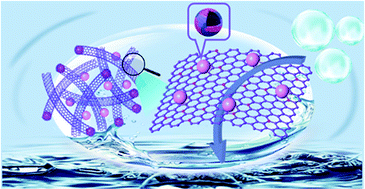In situ immobilization of Fe/Fe3C/Fe2O3 hollow hetero-nanoparticles onto nitrogen-doped carbon nanotubes towards high-efficiency electrocatalytic oxygen reduction†
Abstract
The rational design of affordable, efficient and robust electrocatalysts towards the oxygen reduction reaction (ORR) is of vital importance for the future advancement of various renewable-energy technologies. Herein, we develop a feasible and delicate synthesis of Fe/Fe3C/Fe2O3 hollow heterostructured nanoparticles in situ immobilized on highly graphitic nitrogen-doped carbon nanotubes (referred to as Fe/Fe3C/Fe2O3@N-CNTs hereafter) via a simple hydrogel-bridged pyrolysis strategy. The simultaneous consideration of interfacial manipulation and nanocarbon hybridization endows the formed Fe/Fe3C/Fe2O3@N-CNTs with sufficiently well-dispersed and firmly immobilized active components, regulated electronic configuration, enhanced electrical conductivity, multidimensional mass transport channels, and remarkable structural stability. Consequently, benefiting from the compositional synergy and architectural superiority, the as-obtained Fe/Fe3C/Fe2O3@N-CNTs exhibit excellent ORR catalytic activity, impressive durability and superior selectivity in an alkaline electrolyte, outperforming the commercial Pt/C catalyst and a majority of the previously reported Fe-based catalysts. Furthermore, the rechargeable Zn–air battery using Fe/Fe3C/Fe2O3@N-CNTs + RuO2 as an air-cathode exhibits a higher power density, larger specific capacity and better cycling stability as compared with the state-of-the-art Pt/C + RuO2 counterpart. The explored hydrogel-bridged pyrolysis strategy enabling the concurrent heterointerface construction, nanostructure engineering and nanocarbon hybridization may inspire the future design of high-efficiency electrocatalysts for diverse renewable energy applications.

- This article is part of the themed collection: Nanoscale and Nanoscale Horizons: Nanoparticle Synthesis


 Please wait while we load your content...
Please wait while we load your content...